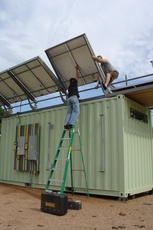Feb 22 2009
Research and development. Industry partnerships. Recycled shipping containers. The University of Houston Gerald D. Hines College of Architecture is primed to sharpen and green the cutting edge of design and architecture with the new UH Green Building Components (GBC), the college’s research initiative to design, develop and implement sustainable, renewable building components for the architecture, engineering and construction industries.
 UH architecture professors Joe Meppelink and Andrew Vrana install solar panels on their shipping container office as part of the college's research initiative, Green Building Components. Meppelink/Vrana
UH architecture professors Joe Meppelink and Andrew Vrana install solar panels on their shipping container office as part of the college's research initiative, Green Building Components. Meppelink/Vrana
“This is unique because there is very little design-based research in our field,” Joe Meppelink, adjunct assistant professor and faculty research coordinator for the college, said. “We will be designing and developing prototype components that will look better and, more importantly, perform better and promote sustainable construction through component-based design.”
The effort is funded by nearly $1 million in grants from Houston Endowment and the Meadows Foundation. The grants, disbursed over the next three years, will allow the college to fund faculty research initiatives as well as purchase state-of-the-art digital fabrication equipment for the design and development of environmentally sensitive building components for commercial use.
“One of our first projects has partnered with Metalab, Harvest Moon Development and Ttweak Renewables, which created a sales office (at Waugh and Hyde Park) from shipping containers and powered them through solar panels. The innovation is in designing the interface between standard solar panels and the unique conditions to which they must attach on each building. Ultimately solar panels will be integrated into building design and component systems such as windows and facades. For now, we need to fully understand and utilize the technology that we have and, in doing so, anticipate the next generations of distributed power generation,” Meppelink said. “The finished containers and their components, already recycled and repurposed, will be 100 percent up-cycled when their job at the site is completed.”
Meppelink said the UHGBC hopes to develop industrial partnerships for other similar projects yielding prototype green building components in the coming year.
The funds also will be used to hire new faculty who will bring their expertise to the UHGBC and into the classroom, guiding students in the latest technologies and grooming the next generation of architects and designers.
“Using pre-fabricated components designed to be environmentally responsible will yield an environmentally superior building,” said Dean Joe Mashburn. “And with this infusion of new technology, talent and partnerships, the college will become a place for industry to create – with our students – new sustainable building products.”